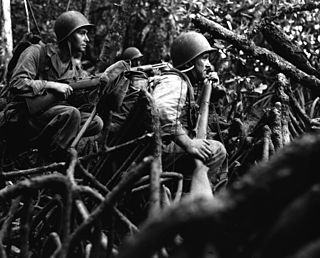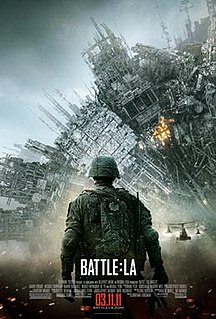
Wake Island is a 1942 American action drama war film directed by John Farrow, written by W. R. Burnett and Frank Butler, and starring Brian Donlevy, Robert Preston, Macdonald Carey, Albert Dekker, Barbara Britton, and William Bendix. The film tells the story of the United States military garrison on Wake Island and the onslaught by the Japanese following the attack on Pearl Harbor.

The Marine Raiders are special operations forces originally established by the United States Marine Corps during World War II to conduct amphibious light infantry warfare. "Edson's" Raiders of 1st Marine Raider Battalion and "Carlson's" Raiders of 2nd Marine Raider Battalion are said to have been the first United States special operations forces to form and see combat during World War II.
Gung ho is an English term, with the current meaning of "overly enthusiastic or energetic". It is thought to have originated from a Chinese phrase, 工合, short for Chinese Industrial Cooperatives.

Gwyllyn Samuel Newton "Glenn" Ford was a Canadian-American actor who often portrayed ordinary men in unusual circumstances. Ford was most prominent during Hollywood's Golden Age as one of the biggest box-office draws of the 1940s, 1950s, and 1960s, who had a career that lasted more than 50 years. Although he played in many genres of movies, some of his most significant roles were in the film noirs Gilda (1946) and The Big Heat (1953), and the high school angst film Blackboard Jungle (1955). However, it was for comedies or westerns which he received acting laurels, including three Golden Globe Nominations for Best Actor in a Comedy movie, winning for Pocketful of Miracles (1961). He also played a supporting role as Clark Kent's adoptive father, Jonathan Kent, in Superman (1978).

So Proudly We Hail! is a 1943 American war film directed and produced by Mark Sandrich and starring Claudette Colbert, Paulette Goddard – who was nominated for an Academy Award for Best Supporting Actress for her performance – and Veronica Lake. Also featuring George Reeves, it was produced and released by Paramount Pictures.

Guadalcanal Diary is a 1943 World War II war film directed by Lewis Seiler, featuring Preston Foster, Lloyd Nolan, William Bendix, Richard Conte, Anthony Quinn and the film debut of Richard Jaeckel. It is based on the book of the same name by Richard Tregaskis.

G.I. are initials used to describe the soldiers of the United States Army and airmen of the United States Air Force and general items of their equipment. The term G.I. has been used as an initialism of "Government Issue," "General Issue," or "Ground Infantry," but it originally referred to "galvanized iron," as used by the logistics services of the United States Armed Forces.

What Price Glory? is a 1926 American silent comedy-drama war film produced and distributed by Fox Film Corporation and directed by Raoul Walsh. The film is based on the 1924 play What Price Glory by Maxwell Anderson and Laurence Stallings and was remade in 1952 as What Price Glory starring James Cagney. Malcolm Stuart Boylan, founder of the U.S. Coast Guard Auxiliary, was title writer on the silent Fox attraction.

The Rifleman's Creed is a part of basic United States Marine Corps doctrine. Major General William H. Rupertus wrote it during World War II following the attack on Pearl Harbor between late 1941 and early 1942, but its first publication was in San Diego in the Marine Corps Chevron on March 14, 1942. His reasoning for writing the Creed is believed to be that he felt that his men had to understand the concept "that the only weapon which stands between them and Death is the rifle…they must understand that their rifle is their life…" In the past, all enlisted Marines would learn the creed at recruit training. However, in recent years the creed has been relegated to the back pages of the standard recruit training guide book and its memorization is no longer considered required for recruits but its significance is passed through drill instructors to their recruits throughout each cycle. Different, more concise versions of the creed have developed since its early days, but those closest to the original version remain the most widely accepted.

To the Shores of Tripoli is a 1942 American Technicolor film directed by H. Bruce Humberstone and starring John Payne, Maureen O'Hara and Randolph Scott. The film was produced by Darryl F. Zanuck. Its cinematography was nominated for an Academy Award in 1943.
Pine-Thomas Productions was a prolific B-picture unit of Paramount Pictures from 1940–1957, producing 81 films. Co-producers William H. Pine and William C. Thomas were known as the "Dollar Bills" because none of their economically made films ever lost money.
Seton Ingersoll Miller was an American screenwriter and producer. During his career, he worked with film directors such as Howard Hawks and Michael Curtiz. Miller received two Oscar nominations and won once for Best Screenplay for fantasy romantic comedy film Here Comes Mr. Jordan (1941) along with Sidney Buchman.

John Edward Tyrrell was an American film actor. He appeared in over 250 films between 1935 and 1947, known for his numerous appearances in the Three Stooges, in a total of 28 shorts with Curly Howard as a third stooge.

Mario Mattoli was an Italian film director and screenwriter. He directed 86 films between 1934 and 1966.

Chetniks! The Fighting Guerrillas is a war film made by Twentieth Century Fox in 1943. The film starred Philip Dorn, Anna Sten, and Martin Kosleck.

Battle: Los Angeles is a 2011 American military science-fiction action film directed by Jonathan Liebesman. The storyline was conceived from a screenplay written by Chris Bertolini, based in part on a World War II incident dubbed the "Battle of Los Angeles". The film is set in modern-day Los Angeles and follows a Marine Staff Sergeant played by Aaron Eckhart who leads a platoon of U.S. Marines, joined by other stranded military personnel, during a global alien invasion. The ensemble cast includes Michelle Rodriguez, Ramon Rodriguez, Bridget Moynahan, Ne-Yo, and Michael Peña.

The Ocean ships were a class of sixty cargo ships built in the United States by Todd Shipyards Corporation during the Second World War for the British Ministry of War Transport under contracts let by the British Purchasing Commission. Eighteen were lost to enemy action and eight to accidents; survivors were sold postwar into merchant service.
The "Marines' Hymn" is the official hymn of the United States Marine Corps, introduced by the first director of the USMC Band, Francesco Maria Scala. Its music originates from an 1867 work by Jacques Offenbach with the lyrics added by an anonymous author at an unknown time in the following years. Authorized by the Commandant of the Marine Corps in 1929, it is the oldest official song in the United States Armed Forces. The "Marines' Hymn" is typically sung at the position of attention as a gesture of respect. However, the third verse is also used as a toast during formal events, such as the birthday ball and other ceremonies.
World War II changed the possibilities for animation. Prior to the war, animation was mostly seen as a form of family entertainment. The attack on Pearl Harbor was a turning point in its utility. On December 8, 1941, the United States Army began working with Walt Disney at his studio, stationing Military personnel there for the duration of the war. The Army and Disney set about making various types of films for several different audiences. Most films meant for the public included some type of propaganda, while films for the troops included training and education about a given topic.

Daiei Film Co. Ltd. was a Japanese film studio. Founded in 1942 as Dai Nippon Film Co., Ltd., it was one of the major studios during the postwar Golden Age of Japanese cinema, producing not only artistic masterpieces, such as Akira Kurosawa's Rashomon (1950) and Kenji Mizoguchi's Ugetsu (1953), but also launching several film series, such as Gamera, Zatoichi and Yokai Monsters, and making the three Daimajin films (1966). It declared bankruptcy in 1971 and was acquired by Kadokawa Pictures.















